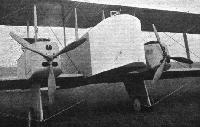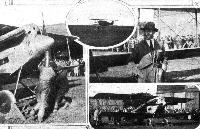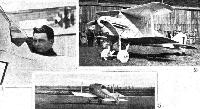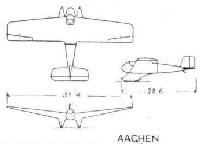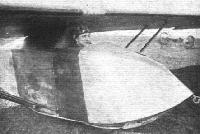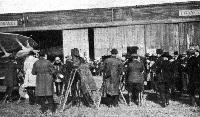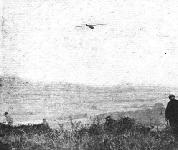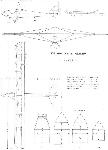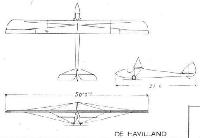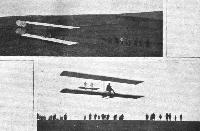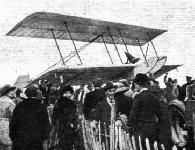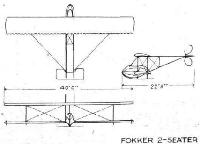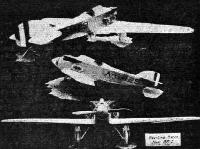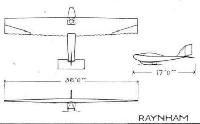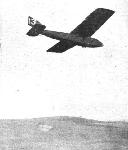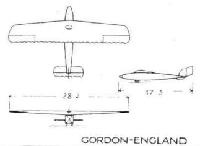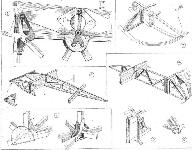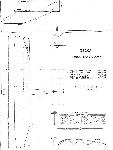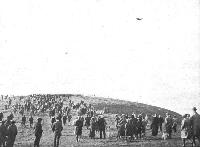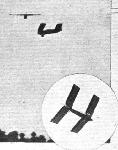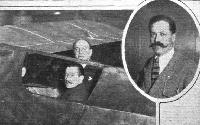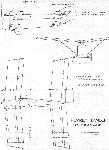Фотографии
-
The Farman "Goliath" upon which Bossoutrot made his record flight, as recorded last week in "Flight." Note the pair of Leitner-Watts 3-bladed metal air-screws which helped the French machine to victory. Moreover, these nine-foot propellers are entirely British, being designed by Mr. Watts, and manufactured for the Metal Air-Screw Co., Ltd., at Messrs. Rubery Owen's well-known works.
Самолёты на фотографии: Farman F.60 Goliath / F.169 - Франция - 1918
-
THE ALBATROS L.57: Note how fuselage deck fairing is carried into the curve of the wing.
Самолёты на фотографии: Albatros L.57 / L.58 - Германия - 1922
-
THE ALBATROS, TYPE L.57 MONOPLANE, ROLLS-ROYCE "FALCON" ENGINE: Three-quarter front view.
Самолёты на фотографии: Albatros L.57 / L.58 - Германия - 1922
-
THE PULITZER TROPHY RACE :- One of the two Army-Curtiss Racers entered by the U.S. Army Air Service. These machines have wing radiators, and are fitted with 375 h.p. Curtiss D 12 engines. One of these machines, piloted by Lieut. R. L. Maugham, won the trophy at a speed of 206 m.p.h.
Самолёты на фотографии: Curtiss CR / R-6 - США - 1921
-
Регистрационный номер: A-6081 THE PULITZER TROPHY RACE: The Navy-Curtiss Racer entered by the U.S. Navy. This machine has radiators embodied in the wings (the previous Navy-Curtiss Racer having Lamblin radiators), 400 h.p, Curtiss CD 12 engine.
Самолёты на фотографии: Curtiss CR / R-6 - США - 1921
-
THE COUPE DEUTSCH: The Nieuport-Delage biplane on which Lasne (inset) won this year's race.
Самолёты на фотографии: Nieuport Nieuport-29 - Франция - 1918
-
The Boulton and Paul "Bolton," two 450 h.p. Napier "Lion" engines.
Самолёты на фотографии: Boulton Paul P.15 Bolton / P.25 Bugle - Великобритания - 1922
-
Регистрационный номер: J6584 Three views from above of the Boulton and Paul "Bolton" all-metal machine, with two Napier "Lion" engines.
Самолёты на фотографии: Boulton Paul P.15 Bolton / P.25 Bugle - Великобритания - 1922
-
THE COUPE DEUTSCH: The Italian representative. 1, Mechanics struggling with the high-compression Flat engine 2, Brack-Papa landing after the race. 3, Signor Brack-Papa, the famous Italian pilot of the Fiat. 4, The 700 h.p. Fiat biplane.
Самолёты на фотографии: FIAT BR - Италия - 1919
-
Регистрационный номер: G-EAXZ THE COUPE DEUTSCH: 1, The British representative, Mr. J. H. James. 2, The Gloucestershire Aircraft Co.'s Mars I, 450 h.p. Napier "Lion" engine. 3, James landing after his struggle with maps.
Самолёты на фотографии: Gloster Mars (Bamel) / Nighthawk / Sparrowhawk - Великобритания - 1921
-
THE PULITZER TROPHY RACE: One of the three monoplanes entered by the U.S. Army Air Service. The Loening cantilever, 600 h.p. Packard.
Самолёты на фотографии: Loening R-4 - США - 1922
-
THE COUPE DEUTSCH: 1, The Nieuport-Delage in the air. 2, The "Sesquiplan" flown by Lecointe. A very pretty little machine, similar to last year's, but with a different wing section. 3, Lecointe landing. A few seconds after this photograph was taken the machine turned over, fortunately without injuring the pilot. 4, M. Sadi Lecointe, the famous Nieuport pilot, who had a marvellous escape when his machine turned over on landing.
Самолёты на фотографии: Nieuport-Delage Ni-D-41 / Sesquiplan - Франция - 1921
-
MR. JEYES' AACHEN MONOPLANE: Inset, the machine in flight.
Самолёты на фотографии: FVA (Flugwissenschaftliche Vereinigung Aachen) FVA-1 Schwatze Duvel/FVA-2 Blaue Maus/FVA-3 Ente - Германия - 1920
-
BRINGING HER BACK: Our photograph shows one way of bringing back a glider to the top of the hill after a flight. The wings are stacked on a German hay cart, the fuselage being trailed behind. The machine shown is the Aachen "Tail-first" monoplane on which Herr Klemperer crashed after getting into a spin when his glider was dropped from a kite balloon.
Самолёты на фотографии: FVA (Flugwissenschaftliche Vereinigung Aachen) FVA-1 Schwatze Duvel/FVA-2 Blaue Maus/FVA-3 Ente - Германия - 1920
-
Aachen
Самолёты на фотографии: FVA (Flugwissenschaftliche Vereinigung Aachen) FVA-1 Schwatze Duvel/FVA-2 Blaue Maus/FVA-3 Ente - Германия - 1920
-
Aachen Monoplane 1921
Самолёты на фотографии: FVA (Flugwissenschaftliche Vereinigung Aachen) FVA-1 Schwatze Duvel/FVA-2 Blaue Maus/FVA-3 Ente - Германия - 1920
-
Munich Monoplane 1921
Самолёты на фотографии: Loessl / Bayerischer Aeroklub Munchen SB-1 Munchener - Германия - 1921
-
THE DARMSTADT MONOPLANE GLIDER "EDITH." In the illustration the machine is just getting away. Note the tow rope dropping from its quick-release in the nose of the fuselage.
Самолёты на фотографии: Darmstadt D-04 - D-07 - Германия - 1922
-
Herr Bottsch in the cockpit of the Darmstadt machine. Note the quick-release in the nose of the fuselage. This machine has made flights of long duration, one being of 1 1/2 hours.
Самолёты на фотографии: Darmstadt D-04 - D-07 - Германия - 1922
-
The Darmstadt monoplane, of which scale drawings were published in our issue of September 21, 1921. Herr Bottsch just managed to land the machine before striking the trees, but damaged the fuselage in doing so.
Самолёты на фотографии: Darmstadt D-04 - D-07 - Германия - 1922
-
Darmstadt Monoplane 1921
Самолёты на фотографии: Darmstadt D-04 - D-07 - Германия - 1922
-
Dresden Biplane 1921/22
Самолёты на фотографии: Dresden D-B01 Stehaufchen - Германия - 1921
-
A DEUTSCH CUP "TAIL-PIECE": What all the pilots had to endure at Etampes. M. Casale as the smiling victim.
Самолёты на фотографии: Bleriot-SPAD S.58 - Франция - 1922
-
THE COUPE DEUTSCH: The Spad representative. 1, M. Andre Herbemont, the famous Spad designer, and M. Jean Casale, pilot of the Spad. 2, the Bleriot-Casale biplane. 3, Casale alighting with engine trouble.
Самолёты на фотографии: Bleriot-SPAD S.58 - Франция - 1922
-
Capt. Broad on the De Havilland Glider No.4 making a flight from Beddingham Hill.
Самолёты на фотографии: De Havilland D.H.52 - Великобритания - 1922
-
The De Havilland Glider "Sibylla" ready for a flight.
Самолёты на фотографии: De Havilland D.H.52 - Великобритания - 1922
-
THE DE HAVILLAND GLIDER: Photograph taken from below of a scale model of the machine.
Самолёты на фотографии: De Havilland D.H.52 - Великобритания - 1922
-
SOME CONSTRUCTIONAL DETAILS OF THE DE HAVILLAND GLIDER: 1. Front portion of the fuselage and the Vee undercarriage. 2. The bulkheads or formers to the apices of which the wing is attached. 3. Details of the top of the rear bulkhead, showing attachment of the wire which forms the ridge of the triangular top of the fuselage. 4 shows construction of superstructure over pilot's cockpit, and 5 some of the smaller details. In 6 is shown one complete elevator flap, with trailing edge cut through to show laminated construction. The leather elevator hinges are indicated in 7, and in 8 is seen the U-bolts and compression struts of the internal wing bracing. 9 shows the bulkhead on which the front edge of the tail plane is mounted.
Самолёты на фотографии: De Havilland D.H.52 - Великобритания - 1922
-
De Havilland Glider
Самолёты на фотографии: De Havilland D.H.52 - Великобритания - 1922
-
De Havilland
Самолёты на фотографии: De Havilland D.H.52 - Великобритания - 1922
-
The Espenlaub monoplane, constructed by a carpenter out of all sorts of odds and ends. In spite of its very rough construction the machine flies very well.
Самолёты на фотографии: Espenlaub E.03 - E.05 - Германия - 1922
-
Fokker starts off on his 37 minutes' flight.
Самолёты на фотографии: Fokker FG-1 - FG-4 - Германия - 1919
-
Fokker steadying the tail of his glider as it is being lifted out of the hangar. On the right the famous Dutch pilot-designer is seen in the seat of his glider.
Самолёты на фотографии: Fokker FG-1 - FG-4 - Германия - 1919
-
FOKKER'S FIRST FLIGHT IN ENGLAND: The upper photograph shows the first start, which was unsuccessful. For the next start the machine was towed by a motor-car, and the machine got into the air as shown in the lower picture.
Самолёты на фотографии: Fokker FG-1 - FG-4 - Германия - 1919
-
THE FOKKER MACHINES: On the left, the small single-seater biplane, with pilot's seat on lower wing. On the right, the two-seater, which has an enclosed nacelle, is seen in the air, piloted by Mr. Olley. Note the central skid and wing-tip guards.
Самолёты на фотографии: Fokker FG-1 - FG-4 - Германия - 1919
-
Lifting the Fokker Glider over the heads of the crowd before the start of the flight.
Самолёты на фотографии: Fokker FG-1 - FG-4 - Германия - 1919
-
Fokker 2-seater
Самолёты на фотографии: Fokker FG-1 - FG-4 - Германия - 1919
-
Регистрационный номер: A-6429 THE PULITZER TROPHY RACE: The Navy BR-2 ("Bee-Line") monoplane, 380 h.p. Wright.
Самолёты на фотографии: Bee Line BR / Booth Racer / Thurston Racer - США - 1922
-
THE PULITZER TROPHY RACE: One of the three monoplanes entered by the U.S. Army Air Service. The Thomas-Morse TM 22 all-metal "parasol," 600 h.p. Packard.
Самолёты на фотографии: Thomas-Morse MB-9 / R-5 / TM-22 - США - 1922
-
THE PULITZER TROPHY RACE: One of the three monoplanes entered by the U.S. Army Air Service. The Verville-Sperry cantilever, 380 h.p. H3 Wright (racing model).
Самолёты на фотографии: Verville Verville-Sperry Racer / R-3 - США - 1922
-
Raynham's Glider pegged down on the summit of Itford Hill.
Самолёты на фотографии: Handasyde glider - Великобритания - 1922
-
WILLING HELPERS: A detachment of the R.A.F. carrying Gordon England's and Raynham's gliders to the top of the hill.
Самолёты на фотографии: Gordon England glider - Великобритания - 1922Handasyde glider - Великобритания - 1922
-
Raynham starting off on his 11 1/2 minutes' flight.
Самолёты на фотографии: Handasyde glider - Великобритания - 1922
-
Raynham
Самолёты на фотографии: Handasyde glider - Великобритания - 1922
-
In spite of its "unlucky" number, Gordon England's monoplane gets up well, and is remarkable for its extremely steady flight.
Самолёты на фотографии: Gordon England glider - Великобритания - 1922
-
Gordon-England
Самолёты на фотографии: Gordon England glider - Великобритания - 1922
-
Sketch of the S.C.W. (Sayers) Glider in flight.
Самолёты на фотографии: Sayers SCW - Великобритания - 1922
-
THE "S.C.W." MONOPLANE GLIDER. Some constructional details. 1. Metal fittings securing spar to top longeron, and also spar root fitting. 2. Construction of wing tip. 3. Details of elevator. 4. Sketch showing spar and rib construction. 5 and 6. Details of rib. 7. A typical fuselage joint, showing three-ply "fish-plates."
Самолёты на фотографии: Sayers SCW - Великобритания - 1922
-
S.C.W. monoplane glider
Самолёты на фотографии: Sayers SCW - Великобритания - 1922
-
S.C.W.
Самолёты на фотографии: Sayers SCW - Великобритания - 1922
-
The Winner: Bringing the Peyret monoplane up to the top of Firle Beacon.
Самолёты на фотографии: Peyret Alerion Tandem - Франция - 1922
-
SOARING AT FIRLE BEACON HILL: General view, showing a small section of the crowds who watched; M. Maneyrol's splendid performance. Note the altitude above starting point.
Самолёты на фотографии: Peyret Alerion Tandem - Франция - 1922
-
NEAR THE FINISH: Our photograph shows the Peyret monoplane and Sqdn.-Ldr. Gray's "Brokker" in the air together. Inset, another view of the Peyret. As the machines approached one another the two pilots would wave a cheery greeting and then drift apart once more. In spite of the darkness the machines did not appear to be in any danger of colliding.
Самолёты на фотографии: Gray, Buchanan Brokker - Великобритания - 1922Peyret Alerion Tandem - Франция - 1922
-
The Winner: M. Maneyrol, in the cockpit of his machine, photographed at Selfridges, where the Peyret monoplane is on view this week. Behind the machine may be seen Lieut.-Commander Larrouy, manager and interpreter to M. Maneyrol. Inset, M. Louis Peyret, who designed and built the winning machine.
Самолёты на фотографии: Peyret Alerion Tandem - Франция - 1922
-
THE PEYRET MONOPLANE: Diagrammatic representation of the control system, by which the wing flaps are used as combined ailerons and elevators.
Самолёты на фотографии: Peyret Alerion Tandem - Франция - 1922
-
THE PEYRET MONOPLANE: Some constructional details. 1, View into the cockpit, showing controls and position of air speed indicator. 2, The differential control by which the flaps are operated as combined ailerons and elevators 3 and 4, Details of the wing bracing strut attachments. 5, One side of the undercarriage. The wheel has been omitted for the sake of clearness. 6, Front wing roots on fuselage. 7, Details of spar attachment to fuselage. Note metal-faced ply-wood wing roots, and quick-release bolts.
Самолёты на фотографии: Peyret Alerion Tandem - Франция - 1922
-
Peyret Tandem Monoplane
Самолёты на фотографии: Peyret Alerion Tandem - Франция - 1922
-
A late-comer with a fine performance: Three-quarter front view of Sqdn.-Ldr. Gray's monoplane. This machine was made from the fuselage of a Bristol Fighter and the top plane of a Fokker D.VII, and was consequently nicknamed the "Brokker."
Самолёты на фотографии: Gray, Buchanan Brokker - Великобритания - 1922
-
The Merriam-Newman monoplane photographed just before the start of the flight which ended in a crash.
Самолёты на фотографии: Merriam glider - Великобритания - 1922
-
Merriam-Newman
Самолёты на фотографии: Merriam glider - Великобритания - 1922
-
THE "AIRDISCO" MONOPLANE: On left, machine is seen taking off for a flight, piloted by Rex Stocken. On the right, a three-quarter rear view of the machine. Note the crescent-shaped wing.
Самолёты на фотографии: Aircraft Disposal Co (ADC) Phi-Phi - Великобритания - 1922
-
Airdisco
Самолёты на фотографии: Aircraft Disposal Co (ADC) Phi-Phi - Великобритания - 1922
Статьи
- Flight
